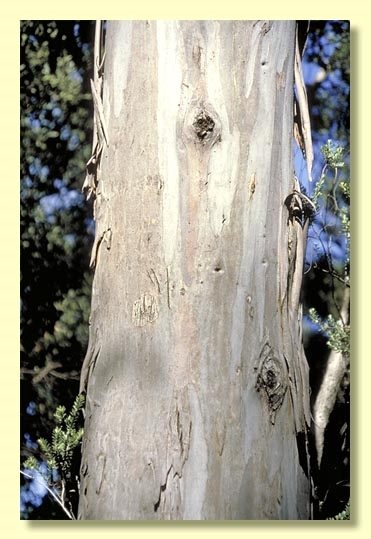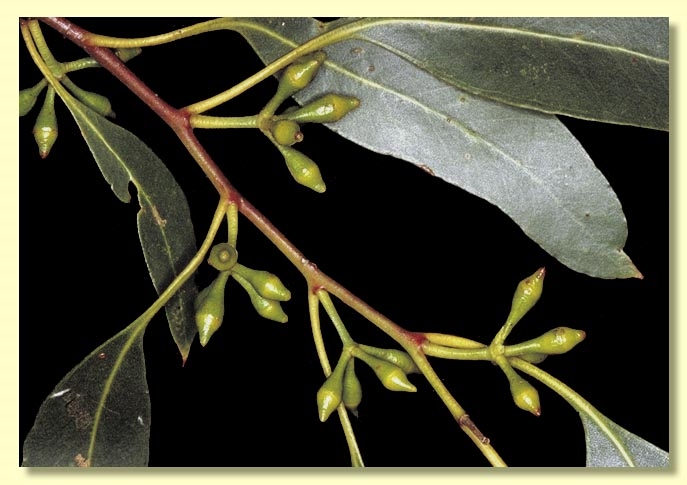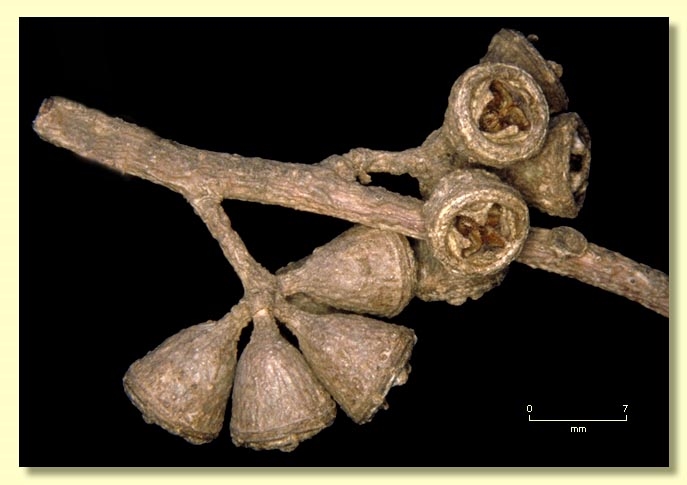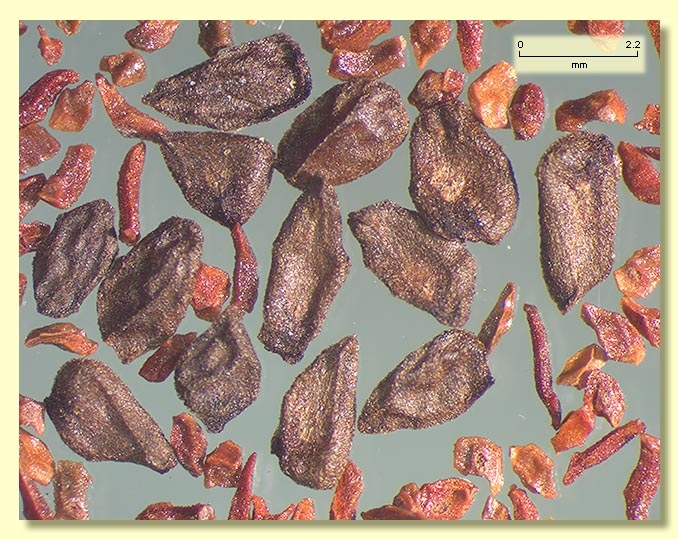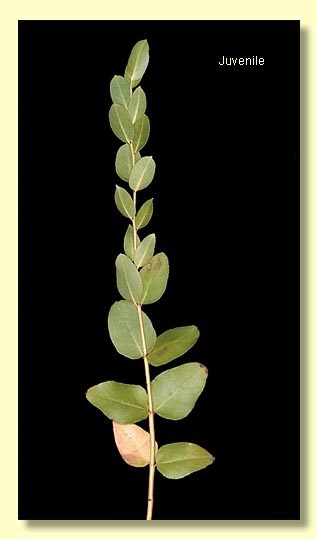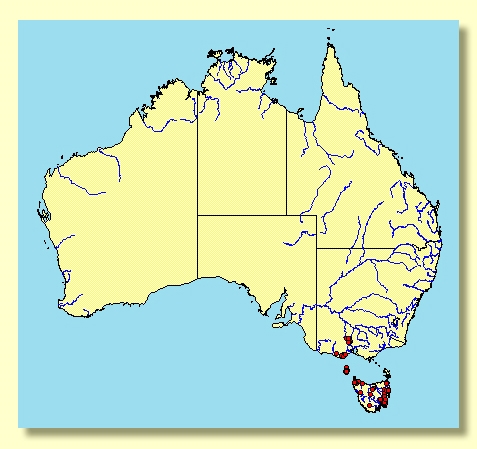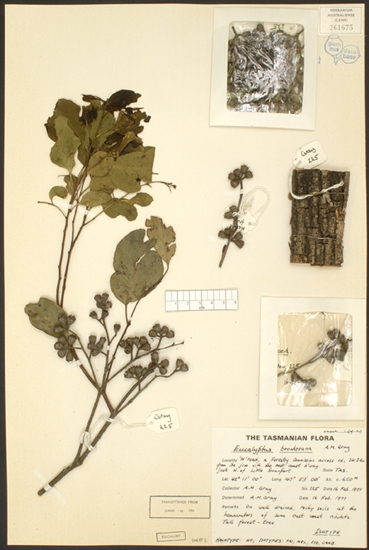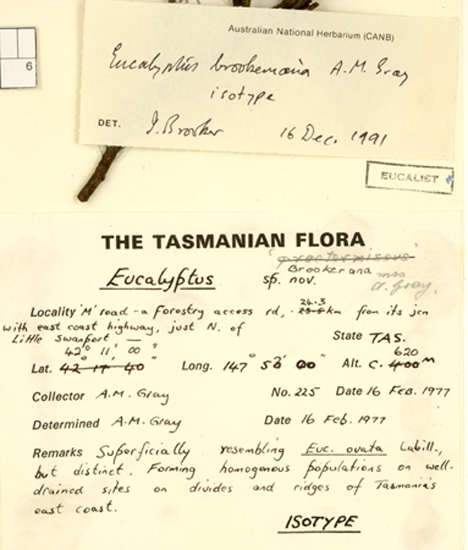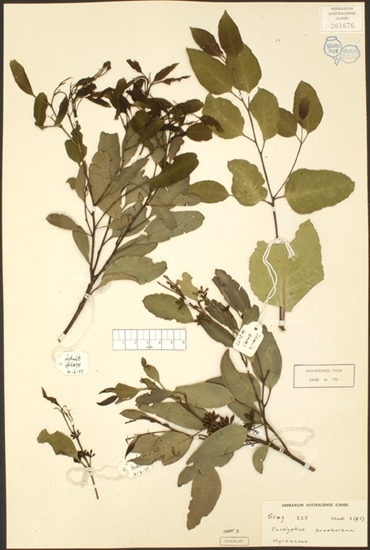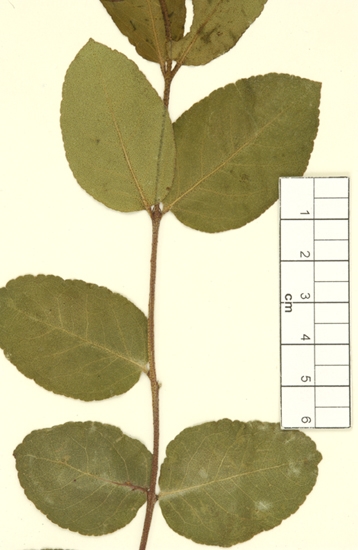Euclid - Online edition
Eucalyptus brookeriana
Eucalyptus | Symphyomyrtus | Maidenaria | Triangulares | Foveolatae
Bark rough, brown or grey, fibrous on lower 1–6 m of trunk, smooth above, white, cream, pinkish, orange, or olive-green to coppery, sometimes with horizontal black scars, often with ribbons of decorticated bark in the upper branches.
Juvenile growth (coppice or field seedlings to 50 cm): stem rounded or square in cross-section; juvenile leaves always petiolate, opposite, soon becoming alternate, orbicular to ovate to elliptical or oblong, 3–11.5 cm long, 2–5 cm wide, discolorous, glandular, margin entire or crenulate, green.
Adult leaves alternate, petiole 1–3.3 cm long; blade lanceolate to falcate or ovate, 6.5–16 cm long, 1.3–5.5 cm wide, flat or undulate, base usually tapering to petiole, margin entire or crenulate, discolorous to weakly so, glossy, green, side-veins usually greater than 45° to midrib, rarely acute, densely to very densely reticulate, intramarginal vein parallel to and well removed from margin, oil glands, numerous, island or intersectional.
Inflorescence axillary unbranched, peduncles 0.4–1.5 cm long, buds 7(9) per umbel, pedicels 0.2–0.5 cm long. Mature buds ovoid to diamond-shaped (0.6–1 cm long, 0.3–0.6 cm wide), green, scar present, operculum conical to beaked (0.3–0.5 cm long), stamens inflexed or irregularly flexed, anthers cuboid or cuneate, versatile, dorsifixed, dehiscing by longitudinal slits (non-confluent), style long, stigma blunt, locules 3 or 4, the placentae each with 4 vertical ovule rows. Flowers white.
Fruit pedicellate (pedicels 0.1–0.5 cm long), cup-shaped, obconical or campanulate, 0.4–0.8 cm long, 0.5–0.7 cm wide, disc raised-annular or convex, or disc level, to slightly descending, valves 3 or 4, exserted or near rim level.
Seeds black, brown or grey, 1–2.5 mm long, ovoid or flattened-ovoid or pointed at one end, usually lacunose, dorsal surface smooth or shallowly pitted, hilum ventral.
Cultivated seedlings (measured at ca node 10): cotyledons bilobed; stems usually square in cross-section; leaves shortly petiolate, opposite for 6 to 8 nodes then alternate, ovate-elliptic, 3.5–9 cm long, 1.3–4 cm wide, base rounded to tapering, margin entire or subcrenulate, apex blunt, slightly discolorous, mid-green above, paler below.
Flowering has been recorded in April, September and November.
Eucalyptus brookeriana is a small to tall tree widely distributed in Tasmania excepting the south-west, and in Victoria, where it is restricted to the Bullarto Plateau near Daylesford. It occupies sites with relatively high rainfall and fertile soils. It has slabs of rough fibrous bark forming a stocking on the trunk on larger trees with smooth barked upper trunk and branches. The crown is glossy green and branchlets non-glaucous. Most of the Tasmanian populations have discolorous adult leaves while those in Victoria are only weakly discolorous.
E. brookeriana can be difficult to distinguish from E. ovata in the buds and fruit, with buds more clearly diamond-shaped in E. ovata, and fruit clearly obcnical, while in E. brookeriana the buds are more ovoid to diamond-shaped and fruit more cupular. The typical juvenile leaves of E. brookeriana are orbicular to oblong, usually crenulate, bright green and glossy, with numerous oil glands and contrast with the duller almost glandless leaves of E. ovata. It can be a tall tree or of smaller woodland form more like typical E. ovata.
A tree of similarly wet sites in the Strzelecki Ranges and Otway Ranges of Victoria, E. strzeleckii, is distinguished most easily from E. brookeriana by its waxy new growth seen on the outside of the crown during the growing season and its concolorous adult leaves. E. strzeleckii was formerly included in E. brookeriana.
Eucalyptus brookeriana belongs in Eucalyptus subgenus Symphyomyrtus section Maidenaria because the cotyledons are bilobed, inflorescences axillary, anthers versatile and seeds flattened-ovoid. Within this large section, E. brookeriana is one of ten species forming subsection Triangulares series Foveolatae further characterised by being swamp-dwellers with fruit ± obconical. It is closest to E. ovata differing as discussed above. The species are E. barberi and E. rodwayi (both Tasmanian endemics), E. brookeriana, E. ovata (both occurring in Tasmania and on the mainland) and E. aggregata, E. cadens, E. macarthurii, E. strzeleckii and E. yarraensis (found only on the mainland). Taxonomy and morphological distinctions in the swamp gums are far from being resolved (fide M.I.H. Brooker).


